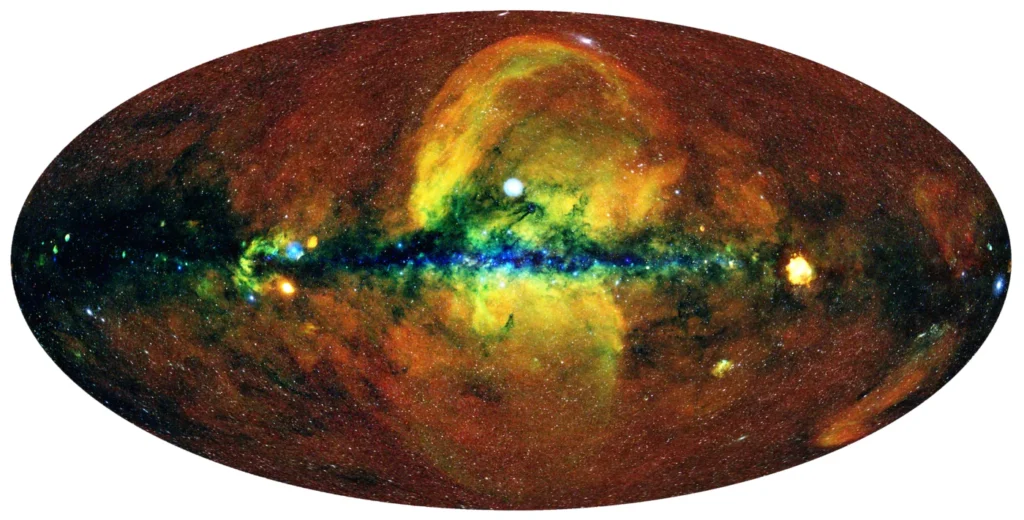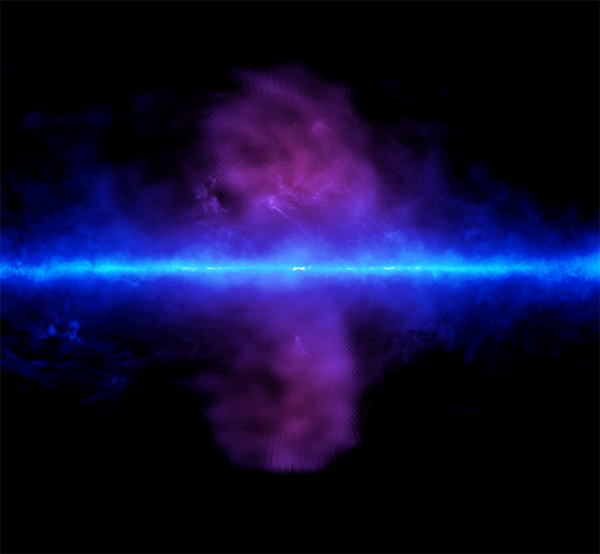Our universe is filled with surprises, and recent discoveries near the center of the Milky Way have sparked considerable intrigue among astronomers and space enthusiasts alike. One such discovery is the identification of giant bubbles emanating from the region around our galaxy’s supermassive black hole, Sagittarius A. But what exactly are these giant bubbles, and why do they matter? Let’s dive deep into the cosmic phenomena to unravel their significance.
Discovery of the Giant Bubbles
The discovery of these colossal bubbles in 2020 by the eROSITA X-ray space telescope, a joint Russian-German mission, marked a significant breakthrough in our understanding of the Milky Way’s center. These bubbles, resembling a massive structure stretching out from the Galactic Center (GC), were initially difficult to place at a precise distance. Were they just a coincidental large local structure, or were they truly linked to the core of our galaxy?

Evidence suggests that these bubbles are far more distant than initially thought, aligning them more closely with the center of our galaxy. The discovery mirrors previous observations of “Fermi bubbles” identified by the Fermi Gamma-ray Space Telescope, which are similarly massive structures that are believed to have formed from intense energy releases at the GC. This similarity led scientists to propose that these new “eROSITA bubbles” might be the result of similar processes: massive amounts of energy released from Sagittarius A*.
The Connection Between Fermi Bubbles and eROSITA Bubbles
The eROSITA bubbles are not an isolated phenomenon but are likely connected to previously discovered Fermi bubbles, which are large-scale structures spanning tens of thousands of light-years above and below the plane of the Milky Way. These bubbles were first discovered in 2010 and were attributed to past energetic events at the galactic center, such as supermassive black hole activity or starburst events.

Recent studies suggest that the eROSITA bubbles might be a larger and more detailed view of the Fermi bubbles. The researchers argue that “the most plausible model for such a structure is a giant bubble rooted in and blown by episodes of energy release at the GC.” This connection between the two types of bubbles emphasizes the dynamic and violent nature of the Milky Way’s core, where bursts of energy can push vast amounts of material into interstellar space.
The Possible Mechanism Behind Bubble Formation
But what causes these enormous bubbles to form? The leading theory involves a process akin to a galactic “chimney.” As stars or other material fall into the supermassive black hole, they are heated to extreme temperatures, creating powerful jets of energy that shoot out along the black hole’s spin axis. According to Scott Mackey, a PhD student at the University of Chicago and lead author of a recent study, “We suspected that magnetic fields are acting as the walls of the chimney and that hot gas is traveling up through them, like smoke.”
Further, Mackey’s team discovered an “exhaust vent” near the top of this chimney, located about 700 light-years above the galactic center. This vent acts as a release point for superheated gas, which travels at high speeds before colliding with cooler gas, creating shock waves and bright X-rays. These X-rays are then detected by Earth-based telescopes, helping astronomers map the structure of these bubbles.
Peter Predehl, the lead author of another study published in Nature, explains that the sharp boundaries of these bubbles are likely the result of shocks caused by massive injections of energy from the inner parts of the galaxy into the galactic halo. The formation of these bubbles is analogous to the “Fermi bubbles” but observed in greater detail, allowing us to understand the “full extent and morphology” of these cosmic structures.
Implications for Galactic Evolution and Black Hole Activity
These findings have significant implications for our understanding of galactic evolution and the activity of supermassive black holes. The presence of these bubbles hints at a feedback mechanism where energy released from black hole activity can influence the larger galactic environment. This energy can heat the surrounding gas, affect star formation rates, and even alter the overall shape and dynamics of the galaxy.
In the context of our Milky Way, these findings suggest that Sagittarius A* has undergone multiple phases of activity, during which it expelled enormous amounts of energy into space. Such events could play a crucial role in determining the distribution of matter in our galaxy, shaping its spiral arms, and possibly influencing the formation of stars. Moreover, by studying these structures, we can draw parallels to other galaxies with active galactic nuclei (AGN) and better understand the universal processes governing galactic evolution.
The Importance of Further Research
While the discovery of these giant bubbles is groundbreaking, it raises more questions than answers. What exactly triggers these massive energy releases? How often do they occur, and what is their impact on the broader galactic environment? To answer these questions, more data and studies are needed.
Future missions and observatories, such as the upcoming X-ray and radio telescopes, could provide more detailed observations of these bubbles and help scientists map their structures in greater detail. By analyzing the energy levels, composition, and dynamics of these bubbles, researchers hope to determine the exact mechanisms that create them and the role of Sagittarius A* in driving these processes.
Additionally, further understanding of the magnetic fields and the role they play in channeling the energy released by the black hole could provide crucial insights. As magnetic fields appear to act as the “walls” of these cosmic chimneys, understanding their behavior could help scientists unlock the secrets of how black holes influence their surroundings on such a grand scale.
Conclusion
The discovery of these giant bubbles emanating from the Milky Way’s heart is more than just an astronomical curiosity; it is a window into the powerful forces that shape galaxies. These bubbles provide tangible evidence of the dynamic processes occurring at our galaxy’s center, revealing episodes of intense energy release that can have far-reaching impacts. As we continue to explore these phenomena, we edge closer to understanding the complex interplay between black holes, their host galaxies, and the universe at large. The next time you look up at the stars, remember that our galaxy is not just a collection of stars and planets—it’s a living, breathing entity with its own dramatic tales to tell. And with each discovery, we uncover more about the universe’s mysterious and ever-evolving story. Let’s continue to unravel these cosmic secrets and learn more about the incredible universe we inhabit.
References:
Predehl, P., Sunyaev, R. A., Becker, W., Brunner, H., Burenin, R., Bykov, A., Cherepashchuk, A., Chugai, N., Churazov, E., Doroshenko, V., Eismont, N., Freyberg, M., Gilfanov, M., Haberl, F., Khabibullin, I., Krivonos, R., Maitra, C., Medvedev, P., Merloni, A., … Wilms, J. (2020). Detection of large-scale X-ray bubbles in the Milky Way halo. Nature.https://www.nature.com/articles/s41586-020-2979-0



















